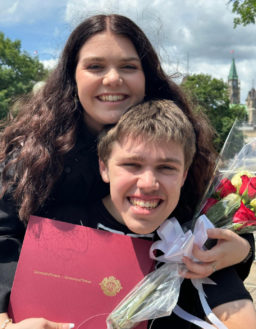Meet the NIH Detectives Cracking Medicine’s Toughest Cases
When people suffering from mysterious afflictions have nowhere left to turn, they come to NIH’s Undiagnosed Diseases Program in Bethesda, where a team specializing in ultra-rare genetic disorders takes on cases that have stumped the medical world—and offers patients new hope.
Written by Matt Ribel | Photographed by Joshua Cogan | Published on May 7, 2024
matthewribel@gmail.com
It’s 8:53 AM, and Dr. William Gahl is dangerously close to pissing off the fire marshal again. ... A legion of young people has come to hear the 73-year-old geneticist present his team’s latest breakthrough. Medical residents are crowding the exits. Research interns with tiny tattoos and giant water bottles are getting bounced at the door. Gahl usually lectures in a 260-seat auditorium in the NIH Clinical Center. This week, however, a conference has exiled him to a windowless classroom in the basement. Everybody is trying to make it work.
Three minutes to showtime, Gahl lumbers into the room and toward the podium. He’s spent the morning mapping out an ADA-compliant route for his patient, and he is sweating. “Does this work?” he asks into a dead microphone. “Of course not. This is the United States government. Nothing works.” (A government shutdown, ultimately averted, is believed to be imminent.) While he tries to diagnose the A/V failure, his teenage patient pilots a motorized wheelchair toward the front of the room, where his parents are fidgeting in their seats. ... When the clock strikes nine, Gahl gives up on the microphone and decides to bellow instead: “Graham, is it okay if I ask you a few questions?”

Diagnosis and treatment have helped Graham manage his disease, allowing him to attend his sister’s college graduation. Photograph courtesy of Graham Tucker.
The young man in the wheelchair nods. He’s wearing a Toronto Maple Leafs T-shirt, and his hair has been buzzed for an electroencephalogram. ... “How old are you?” ... There’s a ten-second pause that feels much longer. “Eighteen,” whispers Graham Tucker, eliciting audible sighs of relief from the audience. After some gentle coaxing from his mother, Tucker reveals that he’s come from Woodstock, the dairy capital of Canada. For a decade, no doctor could identify the disease ravaging his central nervous system. But that’s no longer the case.
Gahl heads the
Undiagnosed Diseases Program, a clinic-of-last-resort established under the auspices of the National Human Genome Research Institute. His team specializes in genetic conditions affecting between one and 50 people worldwide. Using state-of-the-art genomic techniques, they routinely take on cases that have baffled top specialists: hair follicles that produce crystalline spikes, arteries that calcify into bone, neurons that begin failing at birth. Since 2008, they’ve managed to diagnose approximately 400 patients, publish roughly 200 articles in leading medical journals, and discover 30 new diseases, all on a shoestring budget. Though these diseases are rarely treatable, “a diagnosis is still everything,” says Ellen Macnamara, a genetic counselor with the UDP. A diagnosis means insurers are more likely to cover physical therapy and home care. Families can make informed decisions about the future, including whether to bring more children into the world. And after years of wandering alone, patients eventually find others like them, says Macnamara: “A diagnosis offers a home.”
{snip}
